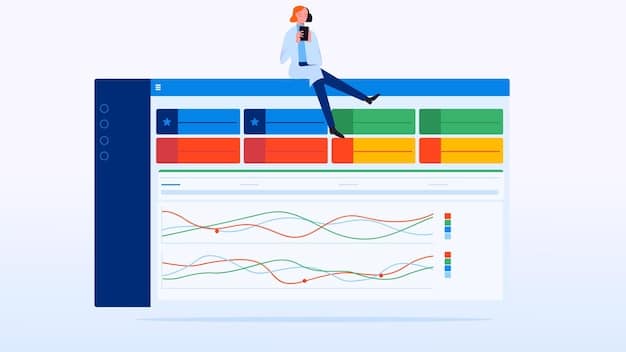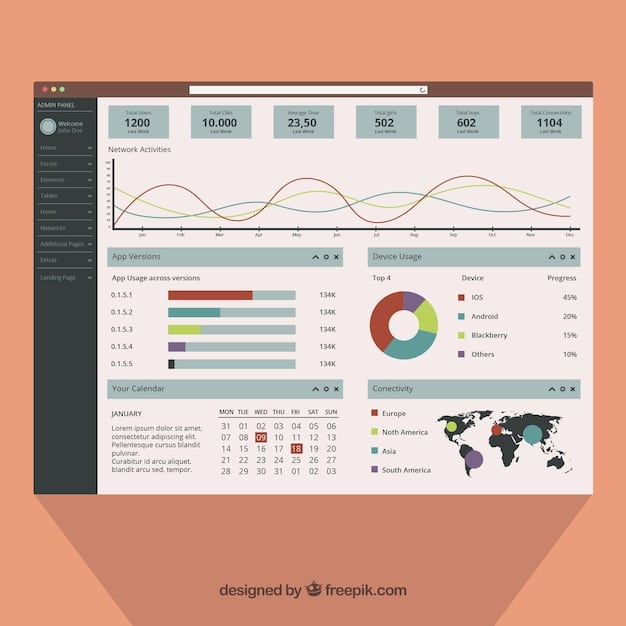A/B Testing for Beginners: Boost Conversions by 10%

Achieving a 10% increase in website conversion rates through A/B testing involves systematically comparing two versions of a webpage element to identify which performs better, ensuring data-driven decisions that optimize user experience and engagement.
In the dynamic landscape of digital marketing, the pursuit of optimal website performance is a relentless quest. For businesses and marketers alike, understanding how to effectively engage users and convert them into valuable leads or customers is paramount. This guide provides Practical Solutions: A/B Testing for Beginners: A Step-by-Step Guide to Improving Your Website’s Conversion Rate by 10%, offering insights and actionable strategies to help you navigate this intricate process with clarity and precision.
Understanding the Core of A/B Testing
A/B testing, often referred to as split testing, is a fundamental technique in digital marketing and web development. It involves comparing two versions of a webpage or app element – Version A (the control) and Version B (the variation) – to determine which one performs better against a defined goal. This goal is typically a conversion metric, such as a signup, a purchase, or a click-through. The core idea is to introduce a single change between the two versions and then measure the statistical significance of any observed differences in performance.
The beauty of A/B testing lies in its scientific approach. Instead of making design or content decisions based on intuition or guesswork, A/B testing allows for data-backed choices. This method eliminates subjective bias, ensuring that improvements are genuinely driven by user behavior and preferences. By isolating variables, you can precisely identify what resonates with your audience and what doesn’t, leading to continuous, incremental improvements that accumulate over time.
The “Why” Behind A/B Testing
Many beginners often ask why A/B testing is so crucial, especially for small businesses or startups. The answer is simple: even minor changes can yield substantial results. Imagine if altering a call-to-action button color increased your sign-ups by just 1%. Over thousands of visitors, that seemingly small percentage translates into a significant boost in leads or sales. A/B testing provides the empirical evidence needed to implement these changes confidently.
- Data-Driven Decisions: Move beyond assumptions and make choices based on actual user behavior.
- Improved User Experience (UX): Identify elements that are confusing or deterring users, leading to a smoother, more enjoyable site experience.
- Increased Conversion Rates: Directly impact your bottom line by optimizing paths to conversion.
- Reduced Risk: Test changes on a small segment of your audience before rolling them out to everyone, minimizing potential negative impacts.
Ultimately, A/B testing is about optimization. It’s about understanding your audience on a deeper level and tailoring your website to meet their needs and expectations more effectively. This continuous process of testing, learning, and refining is what drives sustainable growth and helps you stay competitive in an ever-evolving digital landscape.
Setting Clear Goals and Hypotheses
Before diving into the technicalities of running an A/B test, it’s crucial to establish clear goals and formulate testable hypotheses. Without a clear objective, your A/B test becomes a shot in the dark, yielding data that may not be actionable or meaningful. Your goal should be specific, measurable, achievable, relevant, and time-bound (SMART).
For instance, if your overarching aim is to increase your website’s conversion rate by 10%, break that down. Is it 10% more sign-ups for a newsletter, 10% more product purchases, or 10% more completed contact forms? Pinpointing the exact metric you want to improve is the first step.
Formulating a Testable Hypothesis
Once you have a clear goal, the next step is to formulate a hypothesis. A hypothesis is an educated guess or a proposed explanation made on the basis of limited evidence as a starting point for further investigation. In A/B testing, it typically follows an “If…then…because…” structure.
Consider a scenario where your goal is to increase newsletter sign-ups. You might hypothesize: “If we change the call-to-action (CTA) button text from ‘Submit’ to ‘Get Exclusive Updates,’ then we will see a 15% increase in newsletter sign-ups because ‘Get Exclusive Updates’ clearly conveys the benefit to the user and creates more urgency.” This structured approach helps in focusing your efforts and clearly defining what you expect to achieve.
- Specific Change: Clearly state what element will be altered (e.g., CTA text, button color, headline).
- Expected Outcome: Quantify the anticipated improvement to your conversion metric.
- Reasoning: Explain why you believe this particular change will lead to the predicted outcome. This demonstrates your understanding of user psychology or current user behavior.
It’s vital to ensure your hypothesis is singular. Test only one variable at a time. If you change multiple elements simultaneously (e.g., headline, image, and CTA button), you won’t be able to definitively attribute any performance differences to a specific change. This isolation of variables is paramount for scientific accuracy in A/B testing.
By investing time in setting clear goals and formulating precise hypotheses, you lay a strong foundation for your A/B testing initiatives. This preparatory phase is often overlooked by beginners but is critical for extracting meaningful insights and ensuring that your testing efforts contribute to your overall objective of improving conversion rates.
Identifying What to Test and Why
Once your goals and hypotheses are in place, the next logical step is to identify specific elements on your website that are ripe for testing. This isn’t a random process; it should be guided by your understanding of user behavior, analytics data, and areas of known friction or high drop-off rates. Look for elements that directly influence a user’s decision-making process.
Common candidates for A/B testing include headlines, calls-to-action (CTAs), button colors and text, image choices, form fields, page layouts, and even pricing structures. The “why” behind testing a particular element is just as important as the what. Your reasoning should stem from your hypothesis and existing data that suggests this element might be underperforming or could be optimized for better results.
Leveraging Analytics for Insights
Your website analytics (e.g., Google Analytics) are a goldmine for identifying testing opportunities. Look for pages with high bounce rates, low time on page, or significant drop-offs in conversion funnels. These statistics often indicate areas where users are encountering issues or losing interest.
- High Bounce Rate Pages: Suggests that users are not finding what they expected or the content is unengaging. Test headlines, introductory paragraphs, or immediate visual elements.
- Low Time on Page: Indicates superficial engagement. Consider testing content readability, layout, or multimedia elements.
- Conversion Funnel Drop-offs: Pinpoint where users are abandoning the conversion process. Examine forms, checkout steps, or CTA placements.

User feedback, whether through surveys, heatmaps, or direct comments, can also reveal pain points. For example, if multiple users complain about a confusing navigation menu, that’s a clear signal to test alternative menu structures. The key is to be methodical and data-driven in your selection process, ensuring that your tests address real problems and have the potential for significant impact.
Remember, not everything needs to be tested. Focus your efforts on elements that have a direct influence on your conversion goals. Changing a minor grammatical error, while important for professionalism, is unlikely to drive a 10% increase in conversions. Prioritize elements that are central to the user journey and conversion path.
Designing Your A/B Test Variations
Once you’ve identified what to test, the next critical step is to design your variations. This is where your hypothesis comes to life. Remember the golden rule: test only one variable at a time. This allows for clear attribution of results. If you change multiple elements, you won’t know which specific alteration led to the observed outcome.
Let’s say you’re testing a new CTA button. Your control (Version A) is the existing button. Your variation (Version B) would be the new button. The change could be the button’s color, its text, its size, or its placement, but not all of them simultaneously. If you want to test multiple changes, each change requires its own A/B test or a multivariate test (a more complex testing method for advanced users).
Elements to Consider When Designing Variations
The design of your variations should be purposeful, aiming to address the specific problem identified in your hypothesis. Think about the psychological impact of colors, words, and layouts.
- Headlines: Test different value propositions, urgency, or emotional appeal.
- Calls-to-Action (CTAs): Experiment with different verbs, perceived benefits, or button colors that stand out.
- Images/Videos: Different imagery can evoke different emotions or clarify product benefits. Consider testing human faces vs. product shots.
- Form Fields: Fewer fields often lead to higher conversion rates. Test optional vs. mandatory fields, or multi-step forms.
When creating your variations, ensure they are visually distinct enough to be noticeable, but not so drastically different that they become unrecognizable or jarring to the user. The goal is to make a meaningful change that could influence behavior, not to redesign the entire page. Pay attention to consistency in branding and overall user experience even within your variations.
Before launching, QA (Quality Assurance) your variations rigorously. Ensure all links work, forms submit correctly, and the design renders properly across different devices and browsers. A technical glitch can invalidate your test results or worse, harm your brand perception. A well-designed variation is crucial for obtaining reliable, actionable data.
Implementing and Running Your A/B Test
With your variations designed and thoroughly quality-checked, it’s time to set up and launch your A/B test. This typically involves using an A/B testing tool, which manages the traffic allocation, serves the different versions to users, and collects the data. Popular tools include Google Optimize (though being sunset, alternatives are available), Optimizely, VWO, and Adobe Target.
The process generally involves inserting a small piece of code (a “snippet”) into your website, which allows the tool to control which version of the page a user sees. When a user visits the page being tested, the tool randomly assigns them to either the control or the variation, ensuring a fair distribution of traffic.
Key Considerations for Test Implementation
- Traffic Split: Decide how to split your traffic between the control and variation. For simple A/B tests, a 50/50 split is common.
- Audience Segmentation: For more advanced tests, you might want to test variations only on specific audience segments (e.g., new visitors, mobile users, visitors from a certain geographical area). For beginners, start broad.
- Duration of Test: Do not end a test prematurely. Allow it to run long enough to gather statistically significant data. This duration depends on your website traffic and projected conversion rates. A common mistake is to stop a test as soon as one version appears to be winning, without reaching statistical significance.
- Statistical Significance: This is a crucial concept. It tells you the probability that your test results were not due to random chance. Most A/B testing tools will calculate this for you, but generally, a 95% or 99% significance level is desired before declaring a winner. Running a test until it reaches statistical significance can take days, weeks, or even months, depending on your traffic volume and the magnitude of the expected effect.

During the test, it’s important to monitor performance without interfering. Avoid making other changes to the page or running conflicting tests simultaneously, as this can contaminate your results. Let the data accumulate naturally. Many A/B testing platforms offer real-time dashboards to track progress and identify potential issues, but resist the urge to draw conclusions too early.
Patience is key in this phase. Rushing to declare a winner without sufficient data or statistical significance can lead to implementing a change that merely appears to be better but isn’t actually having the desired impact. Trust the process and the data.
Analyzing Results and Iterating
Once your A/B test has run its course and achieved statistical significance, the most exciting part begins: analyzing the results. This is where you determine if your hypothesis was correct and if your variation truly outperforms the control. Most A/B testing tools provide comprehensive reports, often with visuals, that clearly show the performance of each version against your defined conversion goal. Look for the conversion rate, visitor count, and most importantly, the statistical significance of the difference between the control and variation.
It’s important to look beyond just the “winning” version. Understand *why* one version performed better. Did a clearer CTA text lead to more clicks because it conveyed a benefit? Did a different layout reduce bounce rates because it improved readability? These insights are invaluable because they provide deeper understanding of your users and inform future optimization efforts. A common pitfall is simply declaring a winner without dissecting the why.
What to Do with the Results
Based on your analysis, there are typically three outcomes:
- The Variation Wins: If your variation significantly outperforms the control, congratulations! Implement the winning variation permanently on your website. This is a direct, data-backed improvement.
- The Control Wins (or No Significant Difference): If the control performs better or there’s no statistically significant difference between the two versions, it means your hypothesis was either incorrect or the change wasn’t impactful enough. This isn’t a failure; it’s a learning opportunity. You now know what doesn’t work, which is just as valuable as knowing what does.
- Inconclusive Results: Sometimes, even after running for a sufficient period, the results might remain inconclusive. This could be due to low traffic volumes, an insufficient magnitude of change, or other external factors. In such cases, you might need to refine your hypothesis, design a more impactful variation, or gather more data.
The process of A/B testing is inherently iterative. Winning a test isn’t the end; it’s the beginning of the next test. Every successful change clears the path for the next optimization opportunity. This continuous cycle of testing, learning, and iterating is what drives consistent, measurable improvements in your website’s conversion rates and overall performance. Document your findings, whether positive or negative, to build a knowledge base of what works (or doesn’t) for your specific audience.
Common Pitfalls and Best Practices for Beginners
While the prospect of improving website conversion rates by 10% through A/B testing is exciting, beginners often encounter common pitfalls that can undermine their efforts. Being aware of these traps can save time, resources, and frustration, ensuring your testing journey is productive.
One of the most frequent mistakes is ending a test prematurely, before reaching statistical significance. Observing an early lead for one variation can be tempting, but without sufficient data, this lead might just be due to random chance. Patience is paramount. Always let your test run until it meets the required statistical significance threshold, which most A/B testing tools will indicate. Stopping too soon often leads to implementing changes that don’t actually benefit your conversion rates in the long run.
Best Practices for Successful A/B Testing
- Test One Variable at a Time: As stressed earlier, isolate your changes. This ensures that any observed differences in performance can be directly attributed to the single change you introduced.
- Focus on Impactful Elements: Prioritize testing elements that are directly related to your conversion goals and user journey. Minor, superficial changes are less likely to yield significant results.
- Understand Statistical Significance: Educate yourself on what statistical significance means and why it’s crucial. Rely on your A/B testing tool to confirm when your test results are reliable.
- Don’t Be Afraid of “No Difference”: A test showing no significant difference or even a losing variation is still valuable. It tells you what doesn’t work, preventing you from investing in ineffective changes.
- Continuously Iterate: A/B testing is an ongoing process. Every successful test opens the door for the next one. Maintain a testing roadmap and keep experimenting to find new growth opportunities.
- Consider External Factors: Be aware that external factors not related to your test (e.g., a sudden news event, a competitive seasonal sale, a change in advertising campaign) can influence your results. These should be noted and considered during analysis.
Another common mistake is to ignore the “why” behind the results. Simply implementing a winning variation without understanding the underlying user behavior is a missed opportunity. Dig into your analytics, consider user feedback, and try to piece together the narrative behind the data. This deeper understanding will inform more effective hypotheses for future tests.
Finally, remember that A/B testing is not a one-size-fits-all solution. What works for one website or audience might not work for another. Embrace experimentation, learn from every test, and continually refine your approach. With these best practices in mind, even beginners can effectively leverage A/B testing to significantly improve their website’s performance and conversion rates, reaching that ambitious 10% increase and beyond.
| Key Steps | Brief Description |
|---|---|
| 🎯 Set Goals | Define clear, measurable conversion goals for your tests. |
| 💡 Formulate Hypotheses | Develop “If…then…because” statements for testable changes. |
| 🔬 Design & Test | Create variations and run tests until statistical significance. |
| 📈 Analyze & Iterate | Interpret results and apply learnings for continuous improvement. |
Frequently Asked Questions About A/B Testing
▼
A “good” conversion rate varies significantly by industry, traffic source, and type of conversion. For e-commerce, it might range from 1-3%, while for lead generation or specific landing pages, it could be much higher (5-15% or more). Instead of a fixed target, focus on continuous improvement. A 10% increase on your current baseline, whatever it is, is a strong, achievable goal through consistent A/B testing.
▼
The duration of an A/B test depends primarily on your website’s traffic volume and the magnitude of the expected conversion rate change. It’s crucial to run tests until statistical significance (typically 95% or 99%) is achieved, not just for a fixed period. Most tools estimate required test duration; this could range from a few days for high-traffic sites to several weeks or even months for lower-traffic ones.
▼
When done correctly, A/B testing should not negatively impact your SEO. Google officially supports A/B testing to improve user experience. Key is to avoid cloaking (showing different content to users vs. search engines), using temporary redirects (302 instead of 301), and ensuring original content is always accessible. Properly implemented tests using reliable tools are generally safe for SEO.
▼
A/B testing compares two versions of a single element change (e.g., two different headlines). Multivariate testing (MVT) tests multiple element changes simultaneously on a single page, trying various combinations of those changes (e.g., different headlines AND different images AND different CTAs). MVT requires significantly more traffic and is more complex, typically for advanced users with high traffic volumes seeking complex combinatorial insights.
▼
For beginners, focus on high-impact elements that directly affect conversions. Good starting points include headlines, calls-to-action (CTA) text and button colors, images on landing pages, basic form fields (e.g., number of fields), and the main value proposition statement. These elements are often easy to change with A/B testing tools and can yield noticeable results with relatively low effort.
Conclusion
Embarking on the journey of A/B testing can initially seem daunting, but as this guide illustrates, it’s a systematic and highly rewarding endeavor. By meticulously setting goals, formulating hypotheses, designing purposeful variations, and patiently analyzing results, even beginners can unlock significant improvements in their website’s conversion rates. The pursuit of a 10% increase, or even more, is not merely aspirational; it’s an achievable reality when grounded in data-driven decisions and a commitment to continuous optimization. A/B testing transforms website management from guesswork into a scientific pursuit, ensuring that every change implemented is a step towards better user experience and stronger business outcomes.





